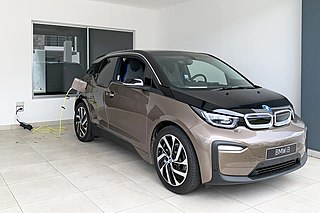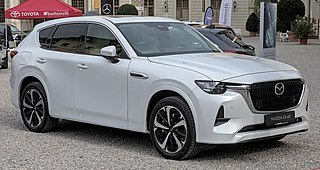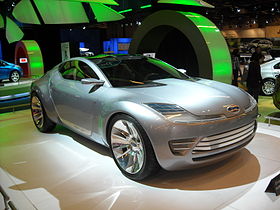
A hybrid vehicle is one that uses two or more distinct types of power, such as submarines that use diesel when surfaced and batteries when submerged. Other means to store energy include pressurized fluid in hydraulic hybrids.

An electric vehicle (EV) is a vehicle whose propulsion is powered fully or mostly by electricity. EVs include road and rail vehicles, electric boats and underwater vessels, electric aircraft and electric spacecraft.

The Volvo C30 is a three-door, front-engine, front-wheel-drive premium compact hatchback manufactured and marketed by Volvo Cars from 2006 to 2013, in a single generation. Powered by inline-four and straight-five engines, the C30 is a variant of the Volvo S40/V50/C70 range, sharing the same Ford C1/Volvo P1 platform. Volvo marketed the C30 as a premium hatchback / sports coupe.

A compressed-air vehicle (CAV) is a transport mechanism fueled by tanks of pressurized atmospheric gas and propelled by the release and expansion of the gas within a pneumatic motor.

The Ford Escape is a compact crossover SUV manufactured and marketed by Ford Motor Company since the 2001 model year. The first Ford SUV derived from a car platform, the Escape fell below the Ford Explorer in size; the Escape is currently sized between the Ford EcoSport and Ford Edge. The 2004 Ford Escape Hybrid was the first hybrid-electric vehicle from Ford, and the first hybrid produced as an SUV.
Twike, based in Rosenthal, is a German manufacturer of light electric vehicles in the European Union vehicle class L5e . The main product, the Twike, is a human-electric hybrid vehicle (HEHV) designed to carry two passengers and cargo. Essentially a velomobile with an electrical hybrid engine, it can be driven in electric-only mode or electric + pedal power mode.

The Ford C-Max is a car produced by the Ford Motor Company from 2003 to 2019. It has a five-door compact multi-purpose vehicle (MPV) design. The Ford Grand C-Max has a longer wheelbase.
Hybrid Synergy Drive (HSD), also known as Toyota Hybrid System II, is the brand name of Toyota Motor Corporation for the hybrid car drive train technology used in vehicles with the Toyota and Lexus marques. First introduced on the Prius, the technology is an option on several other Toyota and Lexus vehicles and has been adapted for the electric drive system of the hydrogen-powered Mirai, and for a plug-in hybrid version of the Prius. Previously, Toyota also licensed its HSD technology to Nissan for use in its Nissan Altima Hybrid. Its parts supplier Aisin offers similar hybrid transmissions to other car companies.

The Mazda Kabura was a concept car shown by the Japanese manufacturer Mazda in 2006.
Hybrid vehicle drivetrains transmit power to the driving wheels for hybrid vehicles. A hybrid vehicle has multiple forms of motive power, and can come in many configurations. For example, a hybrid may receive its energy by burning gasoline, but switch between an electric motor and a combustion engine.
The following outline is provided as an overview of and topical guide to automobiles:

The Ford Airstream was a concept car built by Ford that made its debut at the 2007 North American International Auto Show in Detroit, Michigan. The Ford Airstream was a retro-futuristic crossover utility vehicle that was inspired by the classic Airstream recreational vehicle trailers built since the 1930s. The modern Ford Airstream concept included a plug-in hybrid hydrogen fuel cell drive system, called HySeries Drive, that operated exclusively on electrical power. Ford called the Ford Airstream Concept "a futuristic look at crossovers" as "modern touring vehicle(s)" for recreational travelers. The concept vehicle was designed in cooperation with Airstream, a division of Thor Industries. The design and name of the Airstream were possibly influenced by the Ford Aerostar.

Audi hybrid vehicles are hybrid electric vehicles created by the German carmaker, Audi. Some vehicles listed were concept vehicles, which utilised an internal combustion engine and an electric motor, and were used for research and development (R&D) for potential future use of the technology into possible series production. Audi launched its first hybrid concept car in 1989 called the Audi Duo, and was the first European company to sell a hybrid in 1997, though only in very small numbers.
The XR-3 Hybrid is a plug-in hybrid kit vehicle from Robert Q. Riley Enterprises.

The Nissan Nuvu is a compact all-electric city car produced by Japanese car manufacturer Nissan and presented at the 2008 Paris Motor Show. The concept car featured 2+1 seating, with solar panels shaped like tree leaves on the roof that channel the sun's power through a "tree trunk" conduit in the centre of the vehicle. It can reach about 75 mph (121 km/h) and travel up to about 80 mi (129 km) on an electric charge. A production model based on the Nuvu was not created, but some of the technologies used on the concept were subsequently installed on the production Nissan Leaf.

The Mazda Premacy Hydrogen RE Hybrid or Mazda5 Hydrogen RE Hybrid was a hydrogen powered hybrid car produced by Mazda. Later models were also called the Mazda Hydrogen RE Plug in Hybrid. The first car was unveiled in 2005, with an improved version shown at the 2007 Tokyo Motor Show. Mazda planned for the car to enter production and leased a few cars to end users in 2009 in 2010.
Toyota concept vehicles are transportation devices manufactured or designed by automobile company Toyota from 2000 to 2009. As their name suggests, these vehicles were concepts, and, as such, many were never released to dealerships. Many were developed in conjunction with other corporations such as Sony or Subaru.

The Hyundai Blue-Will is a plug-in petrol-electric hybrid concept compact car designed by the South Korean car manufacturer Hyundai Motor Company. The vehicle was debuted at the 2009 Seoul Motor Show in South Korea.

The Ford Evos is a coupe-style plug-in hybrid grand tourer concept car unveiled to the public at the September 2011 Frankfurt Motor Show by Ford Europe.

The Mazda CX-60 is a mid-size crossover SUV produced by the Japanese automobile manufacturer Mazda since 2022. It is the first vehicle to use Mazda's rear- and all-wheel drive platform with longitudinal engine layout categorised as Large Product Group, which includes a line-up of straight-six engines. It is also the first Mazda vehicle to feature a plug-in hybrid option.
















